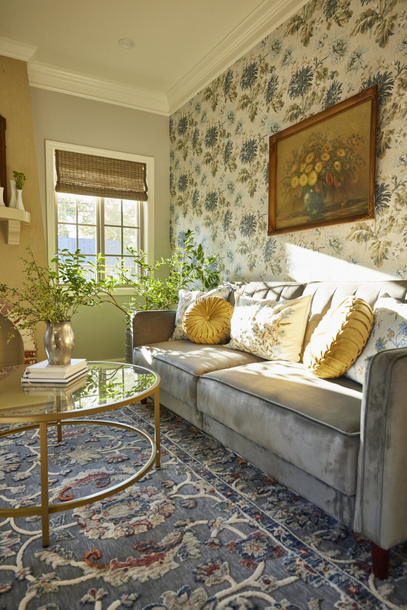
Grandma’s home was a source of comfort. Grandmacore is a lifestyle and aesthetic trend that embraces the cozy, nostalgic, and comforting elements often associated with that home and the accompanying way of life. It’s a reaction against the fast-paced, minimalist, and hyper-digital modern world, and it’s particularly popular with Millennials and Gen Z who are seeking a sense of calm and simplicity.
Young adults face many issues during these tumultuous times. While some of these challenges -like government policies, economic concerns, and relationship issues – have been felt by every generation, others are unique. For example, many young adults are anxious about entering the job market, with some worrying that their jobs could be automated by AI. Others feel unprepared to enter the adult world as a whole. Furthermore, increased global digitization has led to more young adults feeling like they have superficial friendships and an increased fear of missing out. As a result, this generation may feel overwhelmed by a unique combination of all these factors.
Many young adults are seeking comfort and solace in nostalgia and nature. Some remember playing the Nintendo game Animal Crossing as a child, collecting apples, and decorating their own house with various tchotchkes. Others scroll through videos of serene forests and deer cams. Many remember staying at their grandparents’ house, playing board games, and savoring freshly baked cookies.
Grandmacore combines all of these nostalgic and natural aspects to create a lifestyle that combats modern hustle culture and the digital age.
Defining grandmacore?
Grandmacore is a combination of the word “grandma” and the suffix “-core,” which signals an online aesthetic or trend. One of the first mentions of grandmacore was a Buzzfeed article in 2014, which listed various hobbies and items that may be attributed to a stereotypical image of a grandmother and antiquity, such as rocking chairs, knitting, and Fabergé eggs. The term became more popular in the early 2020s, around the time when the COVID-19 pandemic made a global impact. Grandmacore continued to evolve throughout the decade, encompassing fashion, decor, and hobbies.
The aesthetic’s visual aspects focus on the idea of warmth, antiquity, and coziness. Thus, grandmacore often leans towards a maximalist approach. Outfits and rooms usually have several pieces that hold sentimental value, as opposed to fast fashion and mass-produced furniture. Grandmacore fashion staples include handmade, vintage, and warm, modest clothing. Think long, loose skirts, knitted wool cardigans, and oversized sweaters. Accessories include babushkas, headscarves, old rings, and old brooches. Furniture and decorations are often thrifted and antique, such as porcelain teacups, retro armchairs, cross-stitched images, dainty doilies, and vintage candleholders. Trinkets, puzzles, books, balls of yarn, and other non-digital items are also associated with the aesthetic. For both fashion and decor, floral motifs and images of animals are common.
Grandmacore encompasses a variety of hobbies, such as knitting, gardening, baking, and reading. Similar to cottagecore, which is an aesthetic movement that focuses on light colors and living pastorally, grandmacore emphasizes “domestic bliss” (Slone 2020). However, grandmacore typically does not espouse the Christian conservative values that “trad wives” (i.e., traditional wives or women who follow traditional gender roles) hold. Furthermore, although grandmacore does involve some gardening, it does not involve the difficult and gritty self-sufficient farmwork associated with modern homesteading. Instead, grandmacore is associated with comfort. Other less physically strenuous activities include solving crossword puzzles, going on morning walks, and listening to the radio. In summary, grandmacore simply encourages participants to relax and unplug themselves from the fast-paced digital world.
Why is grandmacore becoming more popular?
Grandmacore promises warmth and comfort, and it is no surprise that many members of Gen Z have engaged with this aesthetic. Studies have shown that Gen Z has “the poorest mental health of any generation,” with many feeling pessimistic about issues like climate change and the changing workforce (Axios 2024). These stressors lead to young adults seeking ways to improve their mental health through self-care. Many of the activities associated with grandmacore, such as walking, limiting screen time, and crafting, leave them feeling relaxed.
Other young adults may wholly embrace the aesthetic by not just participating in these activities, but also furnishing their homes with inherited decor and dressing in vintage clothing. As an aesthetic, people can be involved in varying degrees of grandmacore, whether they just crochet after work or also dress the part. Grandmacore is also more financially accessible than other aesthetics, as many items can be thrifted, gifted from grandmothers, handmade, or found on online marketplaces for low prices.
Grandmacore is a reminder for young adults to stop and smell the roses – or the smell of freshly-baked cookies.
Sources
- The Biggest Young Adult Challenges for Gen Z | The Newport Institute
- Escape Into Cottagecore, Calming Ethos for Our Febrile Moment | The New York Times
- Discovering Grandmacore: A Timeless Aesthetic for the Modern Soul | My Little Pink Home
- How to Master the Viral Grandmacore Aesthetic, According to Designers | Good Housekeeping
- Grandmacore Is the Next Biggest Trend of 2023 | Teen Vogue
- Why ‘doing nothing, intentionally’ is good for us: The rise of the slow living movement | BBC
- 39 Reasons You’re #grandmacore | Buzzfeed
- Grandparentcore | Aesthetics Wiki
- Is 2025 the year of ‘grandma’ hobbies? Here are the young people embracing ‘grandmacore’ | USA Today
- The loneliest generation: Inside the Gen Z mental health crisis | Axios
